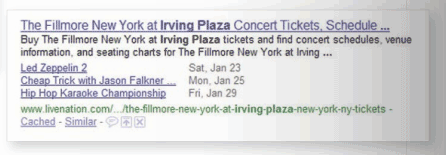Google Rich Snippets


Representing Content the "New" Right Way
Artificial intelligence may evolve to a point where computers understand meaning. But for now, structuring data with semantic markup makes the Web a better, smarter place.
While you may have an intimate understanding of your Web pages and the content they represent, it is Google (and other search engines, too) that will help users find your page(s) by showing them a sample of the content - a "snippet," if you will - on the search result pages. And these snippets are very important, as they are a major factor in whether or not a user clicks on the result.
Think of the summarized information as a new presentation model that applies Google's algorithms to highlight structured data embedded in your Web pages. So can you influence what Google displays in these snippets? Yes, you can - with Google's Rich Snippets.
As an SEO, Internet marketer or webmaster in general, you can influence the results by annotating your pages with structured data in a standard format. By incorporating some standard annotations in your pages, you not only make your structured data available for Google's search results, but also for any service or tool that supports the same standard.
Focus initially on providing semantic markup (rich snippets) for people data featured on your website, then move to providing additional information for review data and event data.
Rich Snippets for People
The most exciting use is associating data with people. Since most websites feature some information about key employees or stakeholders, it only makes sense to start here.
Each individual can have a number of properties to associate data with, including name, title and address, but there is much more valuable data that can be shared. An image link, the person's role (not just the title), a Web page link and even affiliations are all candidates. Also, thanks to Google's ability to recognize XFN properties (friend, contact and acquaintance properties), social relationships can also be identified.

Rich Snippets for Business and Organizations
Another content type to append with semantic markup is the information for your business or organization. Name, URL, address (including sub- properties such as street address, region, postal code and country name), a telephone number and the specific geographic coordinates can be included.
Rich Snippets for Reviews
One of the most interesting aspects of using Rich Snippets on review content is that both individual reviews and review information in aggregate can be marked up. For example, in some instances it might prove useful to show the aggregate number or reviews whereas others might be more interested in showing an editor's rating or review of a particular product or location.
Individual reviews can receive the Rich Snippet treatment with properties such as the name of the item being reviewed, its rating (due to the many possible ways to indicate ratings, Google has provided some guidance on this - https://bit.ly/9kFtlp), the reviewer or author, the date the item was reviewed and a description and summary.
Those wishing to profile aggregate review data on the SERPs can include the item being reviewed, a rating, total number of reviews for the item, votes and a summary. For those who are thinking to include both, Google recommends choosing one format. If a page contains both individual and aggregate review data, only the aggregate markup data will be displayed.
Review sites and social networking sites (Yelp was one of the original adopters during an initial rollout) are those that will benefit the most by using Google's Rich Snippets for reviews, at this point, but all signs point to Google extending to additional areas in the future. When that happens, being prepared will pay significant dividends.

Rich Snippets for Events
Receiving exposure on event information is a great reason to use Rich Snippets. Information such as an event's title, date and venue can help a listing stand out in the search results. Google currently uses the data only for pages containing collections of events, but websites displaying events should consider adding the snippet to their pages. There are several other event fields to include, such as geographic coordinates, event type (festival, concert or lecture), duration and even an image or photo.

Rich Snippets for Recipes
Don't think of Rich Snippets as exclusive to B2B industries. In fact, Google supports Rich Snippets for B2C too, such as recipes. The properties that can be added to rich snippets for recipes are some of the most extensive and detailed. Information such as the type or recipe, prep time, cook time, nutrition and even instructions are just some of the properties that can be included and displayed on the search result pages. Finally, Google has provided the Rich Snippets Testing Tool to help webmasters check their markup - making sure the structured data can be extracted from the page. The tool displays the markup found on a specific Web page and a preview of how that page might appear in search results.

Google's Rich Snippet feature has been rolled out gradually over the past year (initial release was on May 12, 2009) but sparks little conversation across the industry. As structured data becomes more widespread on the Web and on Google, it is time now to get excited about the possibilities and get started marking up your pages. Rich Snippets offers a way for marketers and publishers to extend some level of control and customization on search results pages. And any edge on Google SERPs is a significant one.
________________________
Read more: To display Rich Snippets, Google looks for markup formats (microformats, microdata and RDFa) that can be added to most Web pages. In some caes, it's as quick as wrapping the exiting data on your pages with a few additional tags. Website Magazine has put together a guide to working with these various markup formats for the various rich snippet categories.

Subscribe to Our Newsletter!
Latest in Marketing








